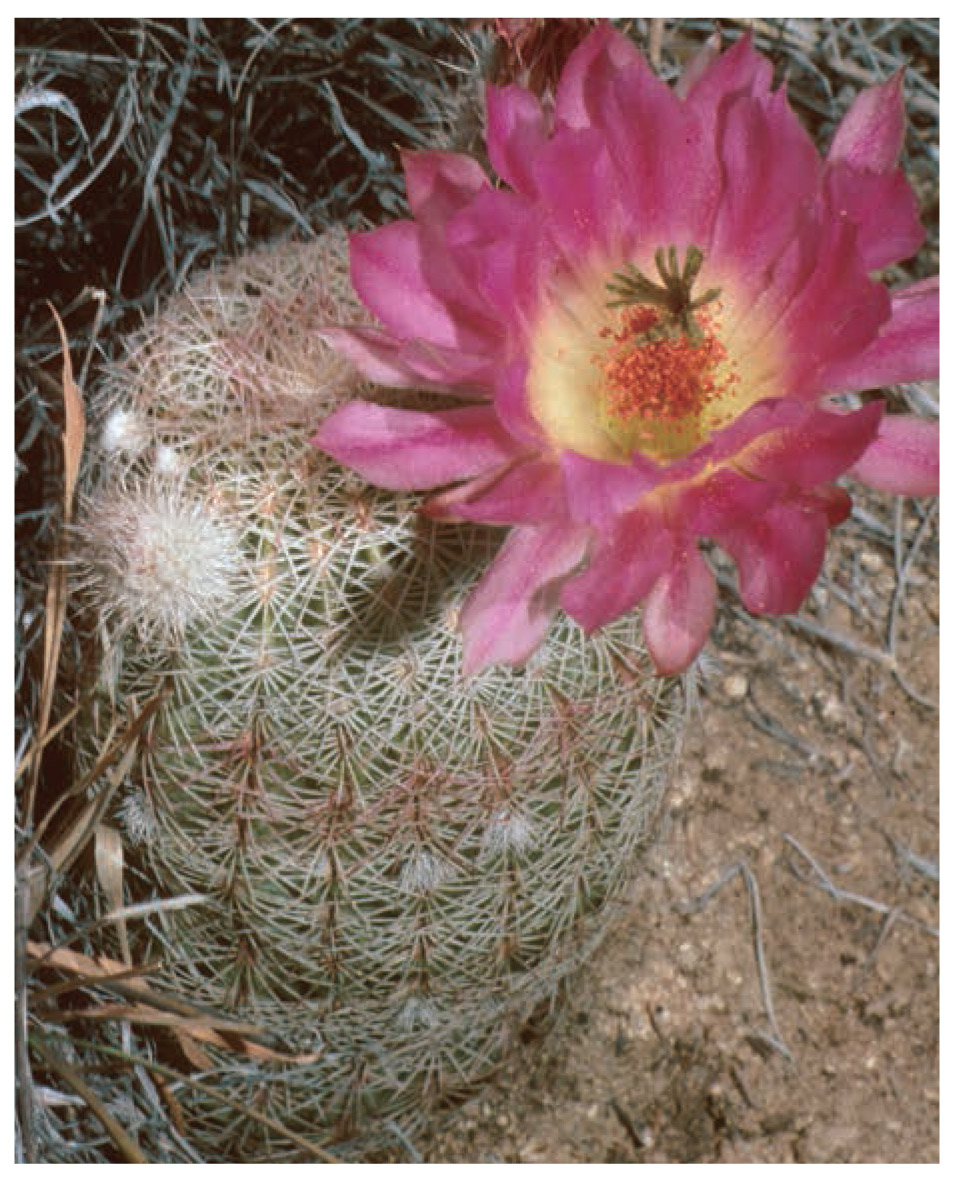

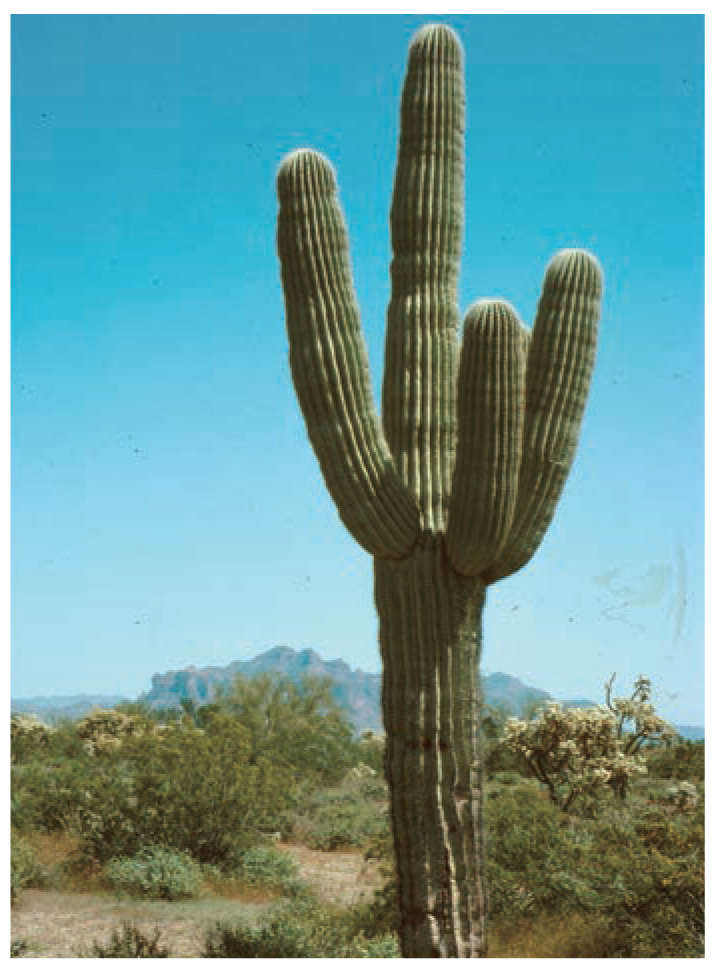
SAGUARO
Giant Cactus
Carnegiea gigantea
Cactus Family (Cactaceae)
Height: To 50’, usually to 30’ high; 2½’ in diameter; and weighing 9 tons.
Flowers: Waxy-white, funnel-shaped, to 3” wide; in crown-like, terminal clusters on arms or main trunk; opening at night and remaining open part of the following day; egg-shaped, fleshy, green fruit (tinged with red), to 3” long, to 1¾” in diameter.
Stems: Green, columnar, treelike trunk, 12 to 30 prominent ribs; branching well up on main trunk when older, branches to 20” in diameter.
Spines: White-gray, sometimes tinged with pink; 15 to 30 per areole; to 3” long, the longest pointed downward.
Blooms: May–June.
Elevation: 600 to 3,600’.
Habitat: Rocky slopes and well-drained flats in the Sonoran Desert.
Comments: The largest cactus in the U.S., saguaros grow very slowly, but live for 150 to 200 years. In their first year, they grow only about ½”. They reach about 1’ in 15 years; 10’ in 40 to 50 years; and 12 to 20’ in 75 to 100 years, when arm buds usually appear.
Young saguaros cannot survive either the heat of the desert sun or trampling; they usually grow under a “nurse” plant, such as a creosote bush or a paloverde tree. Spines on the stems of older plants provide shade to the trunk.
Once saguaros reach a height of about 8’, the first flower buds appear. Flowers smell like ripe melon and attract bees and other insects during the daytime, and bats and moths at night. Fullgrown saguaros produce at least 100 fruits in a season. When mature in July, the fruits split open, revealing their scarlet linings, deep red pulp, and up to 2,000 tiny, jet-black seeds.
One species of Carnegiea in Arizona. Photograph taken at Usery Mountain Recreation Area, April 6.

BEEHIVE CACTUS
Coryphantha vivipara
Cactus Family (Cactaceae)
Height: To 8”.
Flowers: Pink, 2½” wide, day-blooming; followed by green, oval fruit to 1” long, ⁵⁄₈” in diameter.
Stems: Green and globular, to 3” in diameter; forming dense clumps.
Spines: Central spines: reddish to brown at tips, white at base, to ¾” long. Radial spines: white, to ⁵⁄₈” long.
Blooms: May–July.
Elevation: 4,700 to 7,200’.
Habitat: Rocky, sandy ground in juniper woodlands and ponderosa pine forests.
Comments: Nine species of Coryphantha in Arizona. Photograph taken in vicinity of Kohls Ranch, May 23.
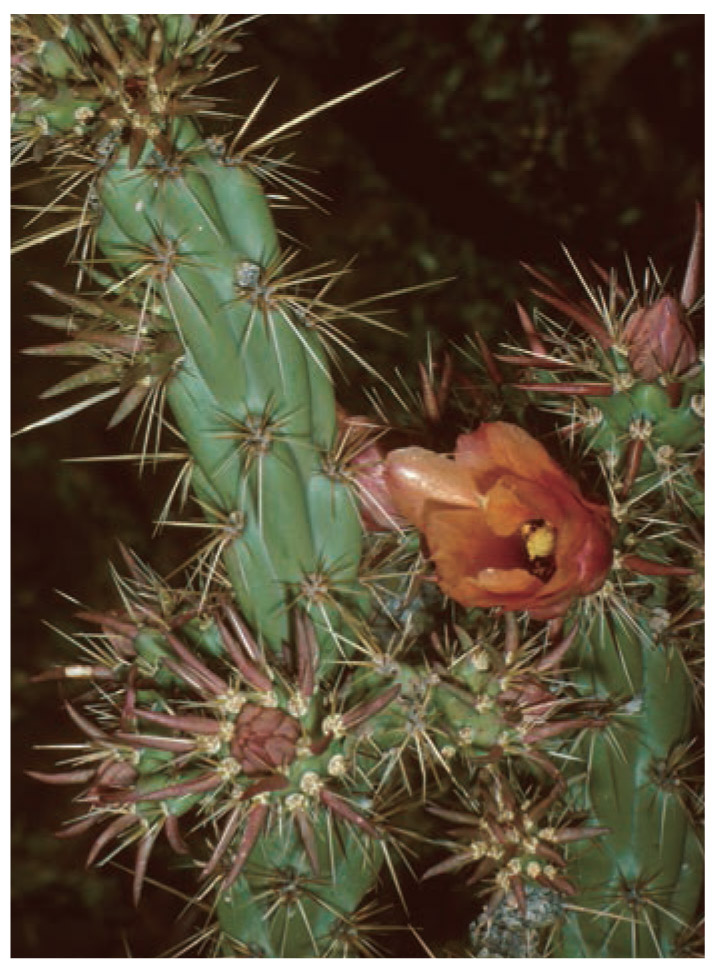
BUCKHORN CHOLLA
Cylindropuntia acanthocarpa (Opuntia acanthocarpa)
Cactus Family (Cactaceae)
Height: Shrubby to treelike, to 6’.
Flowers: Variable, from yellow to orange to red; to 2¼” wide, followed by oval, dry fruit with long spines; to 1½” long. When seeds mature, fruit falls from plant before winter.
Joints: Green, cylindrical, to 20” long, 1¼” in diameter, with elongated tubercles or knoblike projections.
Spines: Straw-colored, stout, 12 or more in a cluster; to 1½” long.
Blooms: Mid-April–late May.
Elevation: 500 to 3,500’.
Habitat: Sandy soils of slopes and washes.
Comments: Native Americans ate flower buds after steaming them. Seventeen species of Cylindropuntia in Arizona. Photograph taken at Usery Mountain Recreation Area, April 6.
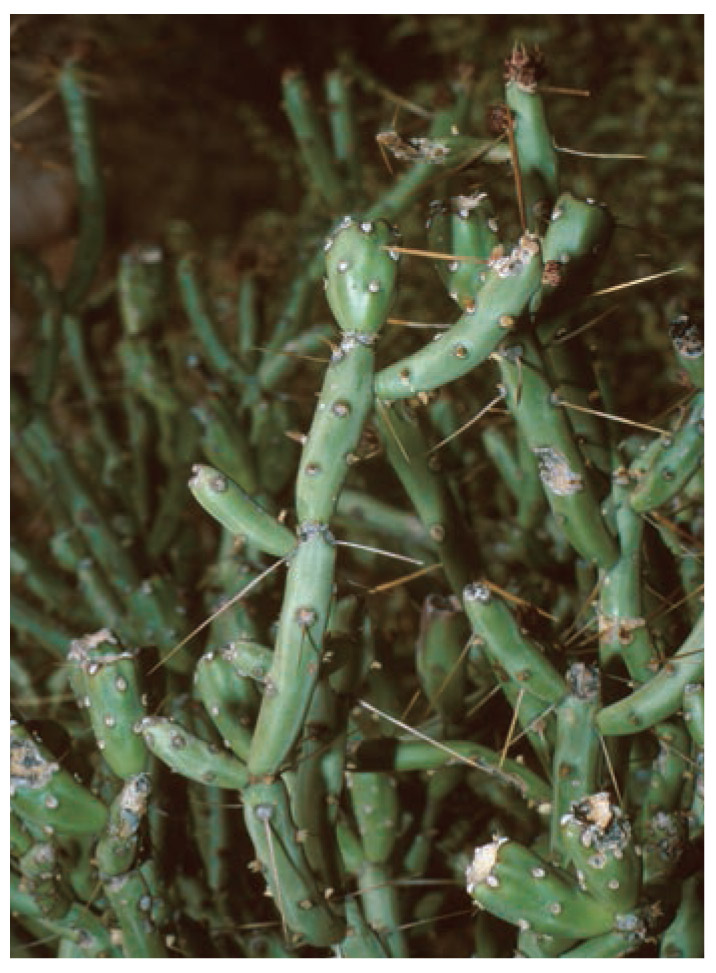
PENCIL CHOLLA
Cylindropuntia arbuscula (Opuntia arbuscula)
Cactus Family (Cactaceae)
Height: Shrubby to treelike, to 9’, but usually much less.
Flowers: Yellow, greenish or brownish red; to 1” long, ⁵⁄₈” wide; followed by green fruit tinged with purple or red; smooth, spineless, and elongated, to 1½” long, ⁷⁄₈” in diameter, lasting through winter.
Joints: Green, nearly smooth; to 6” long, ½” in diameter.
Spines: Reddish or tan, straight, up to 4 per cluster; largest spine facing downward; to 1½” long.
Blooms: May–June.
Elevation: 1,000 to 3,000’.
Habitat: Gravelly and sandy plains, valleys, and washes.
Comments: Seventeen species of Cylindropuntia in Arizona. Photograph taken at Saguaro National Park West, March 31.
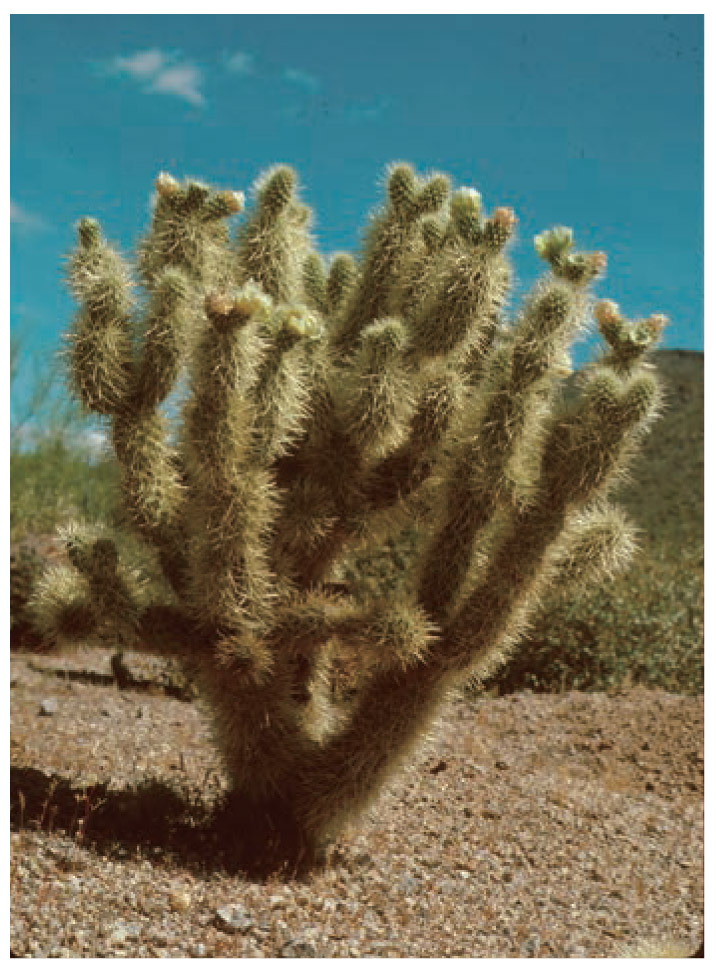
TEDDY BEAR CHOLLA
Jumping Cholla
Cylindropuntia bigelovii var. bigelovii (Opuntia bigelovii)
Cactus Family (Cactaceae)
Height: Shrubby to treelike, to 5’; rarely to 9’.
Flowers: Greenish or yellowish streaked with lavender, to 1½” wide; near end of joint; followed by yellowish, egg-shaped, knobby fruit to ¾” long, ³⁄₈” wide.
Joints: Light green to bluish green, cylindrical; to 10” long, 2½” in diameter; form arms at top of main stem.
Spines: Silvery to golden when young, black when old; dense, backward-facing barbs; to 1” long.
Blooms: February–May.
Elevation: 100 to 3,000’.
Habitat: Desert to rocky hillsides.
Comments: Joints detach very easily when brushed against, causing people to believe joints “jump off” plant. Detached joints root quickly in desert soil, creating dense thickets. Pack rats carry spiny joints to nest sites, often creating a huge pile to ward off enemies. Despite spines, cactus wrens favor this species and chain fruit cholla as nest sites. Seventeen species of Cylindropuntia in Arizona. Photograph taken at Usery Mountain Recreation Area, April 22.
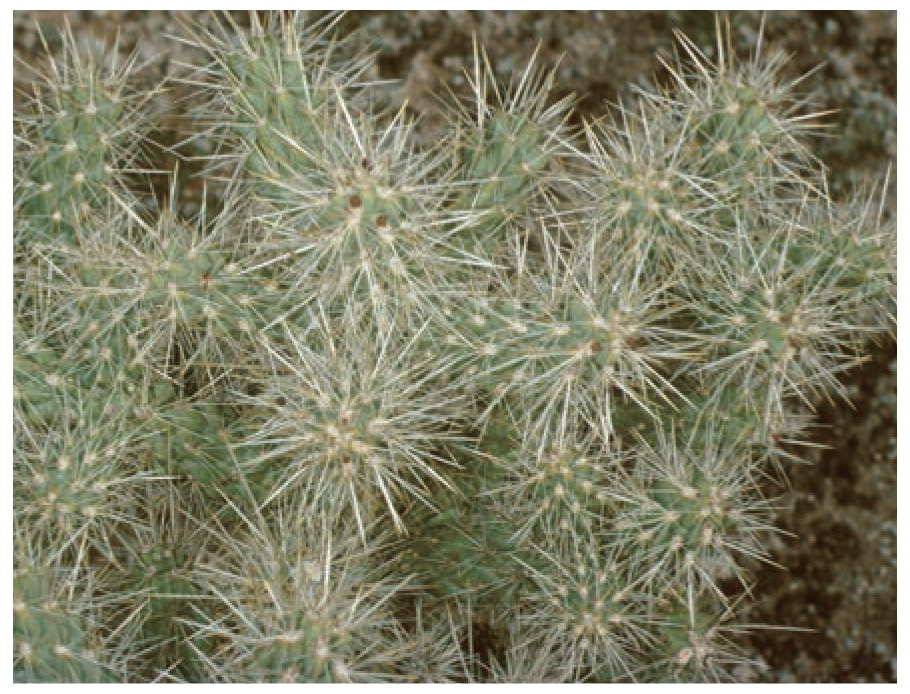
SILVER CHOLLA
Golden Cholla
Cylindropuntia echinocarpa (Opuntia echinocarpa)
Cactus Family (Cactaceae)
Height: To 4’.
Flowers: Greenish yellow, outer parts streaked with red; to 2½” wide; followed by green, eggshaped fruit with spines on upper half; to 1¼” long, ¾” wide; turning light tan at maturity.
Joints: Green, cylindrical, with conspicuous tubercles to ³⁄₈” long; joints generally to 6” long, 1½” wide.
Spines: Silvery or golden, very dense, 3 to 12 per areole; straight, pointing in all directions, narrow; tapering from base; to 1½” long.
Blooms: April.
Elevation: 1,000 to 4,000’.
Habitat: Flats, slopes, and washes.
Comments: Many-branched. Seventeen species of Cylindropuntia in Arizona. Photograph taken in Alamo Lake area, February 26.

CHAIN-FRUIT CHOLLA
Jumping Cholla
Cylindropuntia fulgida var. fulgida (Opuntia fulgida)
Cactus Family (Cactaceae)
Height: Shrubby to treelike, to 15’, usually less.
Flowers: Deep pink to lavender; to ¾” wide; forming on previous year’s pendent fruit, thus length of fruit chain increases each year. Fruit is green, oval, to 1½” long, 1” in diameter.
Joints: Light green, cylindrical; to 6” long, detach easily.
Spines: Grayish to yellowish, barbed, 2 to 12 per areole; to 1¼” long. Variety mamillata has sparse, thin spines, giving the plant a much greener appearance.
Blooms: May–August.
Elevation: 1,000 to 3,000’.
Habitat: Deserts and hillsides.
Comments: Joints seem to “jump” from plant when only slightly touched. Seeds are rarely fertile. Plant reproduces when fruit or segment falls to ground and forms roots, starting new plant. Fruits eaten by cattle; plant is pollinated by bees. Cactus wrens and curve-billed thrashers nest in this cactus. Seventeen species of Cylindropuntia in Arizona. Photograph taken at Usery Mountain Recreation Area on January 24.
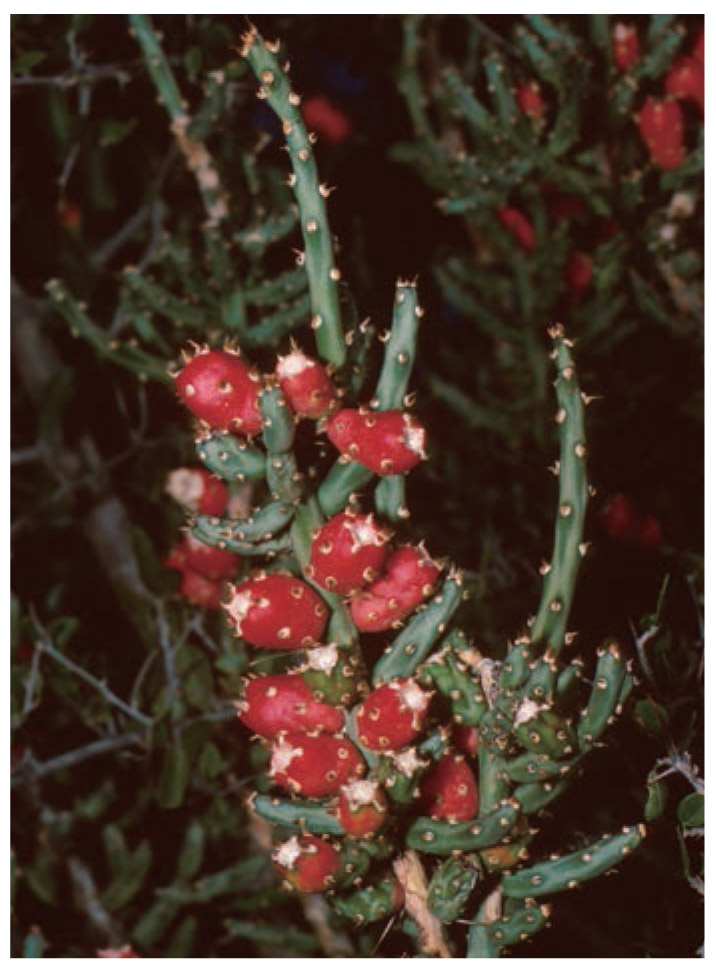
DESERT CHRISTMAS CACTUS
Tesajo
Cylindropuntia leptocaulis (Opuntia leptocaulis)
Cactus Family (Cactaceae)
Height: To 3’ when growing in the open; taller and more vinelike when growing among desert trees.
Flowers: Greenish yellow; to 1” wide; followed by bright red fruit, fleshy at maturity; to ½” long, ⁷⁄₁₆” in diameter.
Joints: Dark green, cylindrical, branched; to 16” long, ½” in diameter.
Spines: Grayish, straight, to 2” long.
Blooms: May–June.
Elevation: 1,000 to 4,000’.
Habitat: Washes, slopes, and flat areas.
Comments: Red fruits remain on stems much of winter. Seventeen species of Cylindropuntia in Arizona. Photograph taken at Tortilla Flat, November 1.

DIAMOND CHOLLA
Cylindropuntia ramosissima (Opuntia ramosissima)
Cactus Family (Cactaceae)
Height: To 5’, but usually less.
Flowers: Apricot to brown with some lavender or red; to ½” wide; followed by brownish, spiny, elliptical fruit to ¾” long, ½” in diameter.
Stems: Grayish green, slender, flattened, and platelike; diamond-shaped, grooved or notched tubercles (projections on joints); to 4” long.
Spines: Yellow to tan part-way, grayish toward stem; barbed, thin, straight, set in a groove; to 2¼” long.
Blooms: May–September.
Elevation: 100 to 2,000’; at times to 3,000’.
Habitat: Washes and desert flats in sandy soil.
Comments: Bushy, matted, many-branched. Seventeen species of Cylindropuntia in Arizona. Photograph taken in Kofa Mountains, February 22. Diamond-shaped, notched, or grooved tubercles are unique to this cholla.
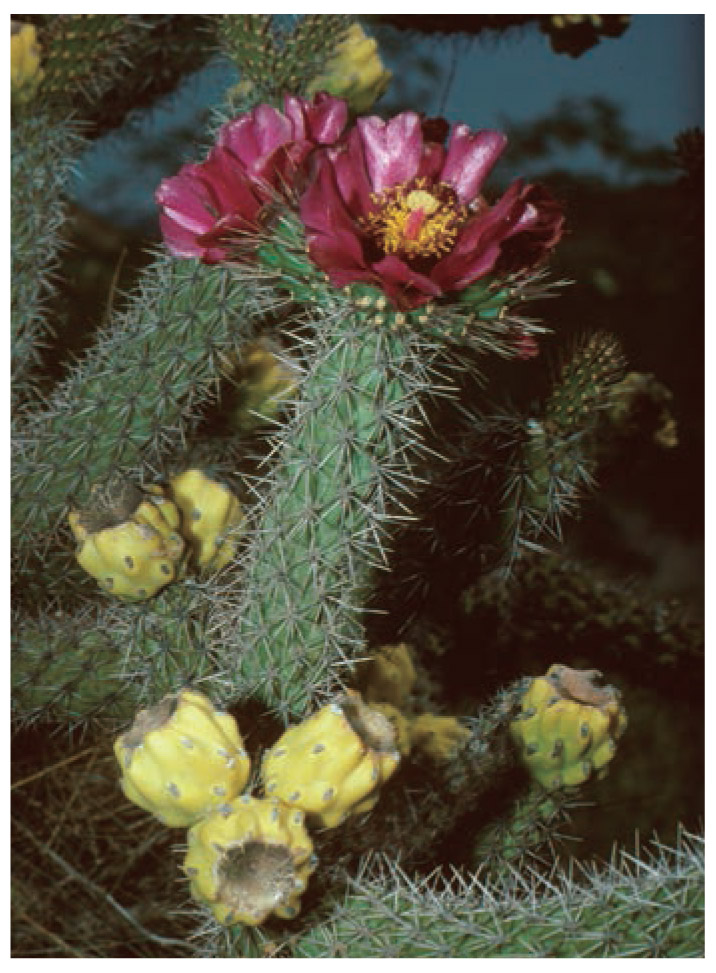
CANE CHOLLA
Walkingstick Cholla
Cylindropuntia spinosior (Opuntia spinosior)
Cactus Family (Cactaceae)
Height: Shrubby to treelike, to 8’.
Flowers: Variable in color, white or yellowish or red or purple; to 3” wide, followed by yellow, eggshaped fruit to 1¾” long, to 1” in diameter; fruits persist through winter.
Joints: Light green, to 12” long, 1” in diameter; with numerous, elongated tubercles or projections.
Spines: Gray to pinkish, up to 20 per areole, straight, widely radiating, barbed, to ³⁄₈” long.
Blooms: May–June.
Elevation: 1,000 to 5,000’.
Habitat: Desert grasslands and desert mountainsides.
Comments: Fruits eaten by cattle; Native Americans ate fruits raw or cooked. Cactus wrens nest in branches. Seventeen species of Cylindropuntia in Arizona. Photograph taken at Roper Lake, May 2.
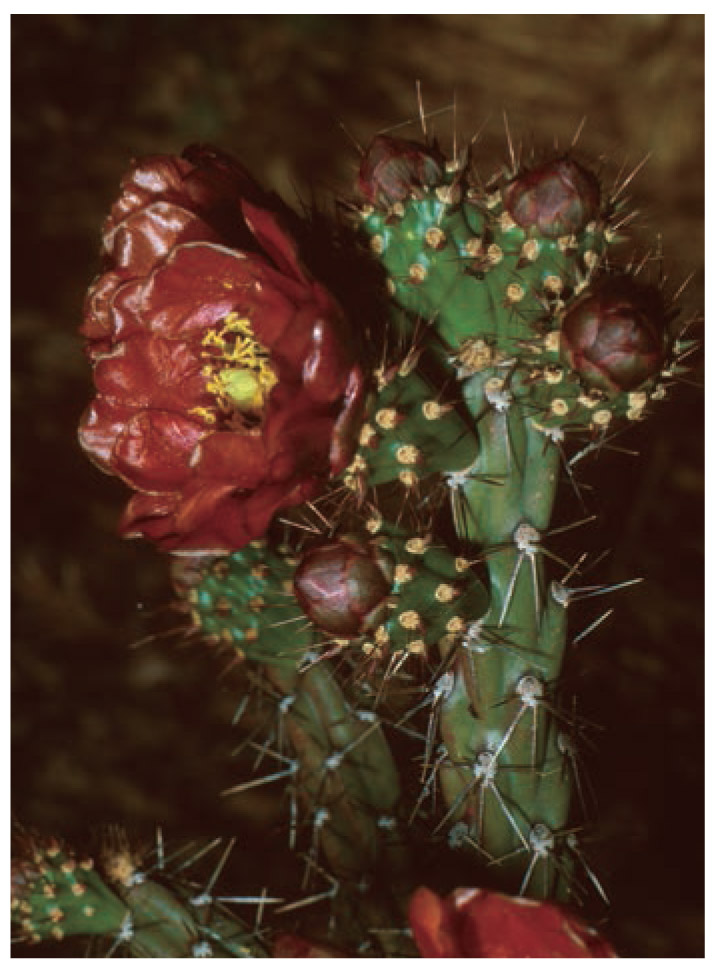
STAGHORN CHOLLA
Cylindropuntia versicolor (Opuntia versicolor)
Cactus Family (Cactaceae)
Height: Shrubby to treelike, to 15’, usually less.
Flowers: Orange, brown, yellow, or red (very variable); to 2¼” wide; followed by green (tinged with purple to red), pear-shaped, fleshy, spineless fruit to 1¾” long, which remain attached during winter.
Joints: Green, elongated, to 14” long, 1” in diameter, with long, knoblike projections.
Spines: Gray or purplish, 7 to 10 in a cluster; to ⁵⁄₈” long; spread at all angles.
Blooms: May.
Elevation: 1,000 to 4,000’.
Habitat: Sandy washes, plains, and canyons.
Comments: Has forked branches resembling deer antlers. New fruits often develop on last year’s fruits, occasionally a chain of 2 or 3 is seen. Seventeen species of Cylindropuntia in Arizona. Photograph taken in Tucson area, May 12.
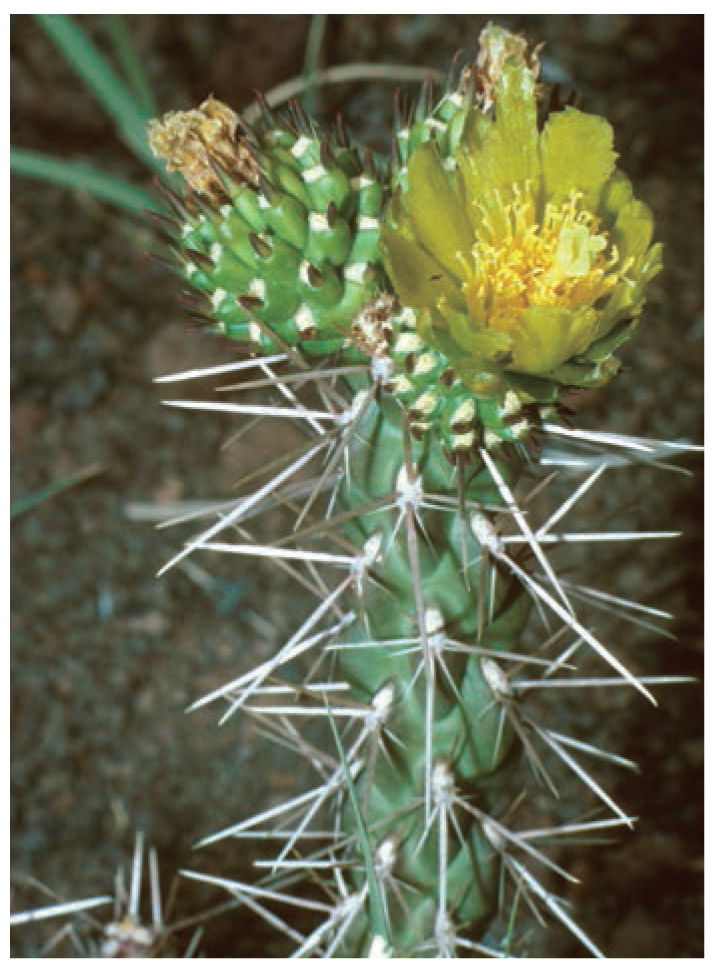
WHIPPLE CHOLLA
Cylindropuntia whipplei (Opuntia whipplei)
Cactus Family (Cactaceae)
Height: To 2½’ when shrubby.
Flowers: Pale yellow to lemon yellow; to 1¼” wide; followed by a yellow, spineless, nearly round to egg-shaped fruit; with shallow cavity at top; to 1¼” long, ¾” wide; remaining through winter.
Joints: Green, cylindrical, tubercles to ³⁄₈” long; joint to 6” long, ¾” wide.
Spines: White to pinkish tan, needlelike; 7 to 14 per areole; 1 long spine in cluster to 2” long.
Blooms: June–July.
Elevation: 4,500 to 7,000’.
Habitat: Plains and grasslands.
Comments: Plants often form mats or grow as low bushes. Seventeen species of Cylindropuntia in Arizona. Photograph taken at Wupatki National Monument, June 5.

TURK’S HEAD
Blue Barrel
Echinocactus horizonthalonius
Cactus Family (Cactaceae)
Height: To 12”; usually closer to 8”.
Flowers: Pink, funnel-shaped, opening fully to 2¾” wide; followed by dry fruit, to 1” long, ½” in diameter, covered with woolly hairs.
Stems: Bluish green, with flattened globe to short columnar shape; to 8” in diameter.
Spines: Gray; central spine curving downward, to 1¼” long; radial spines, to 1” long, spreading in all directions.
Blooms: May–June.
Elevation: 3,000 to 3,500’.
Habitat: Desert.
Comments: 8-ribbed. Two species of Echinocactus in Arizona. Photograph taken at Tohono Chul Park, Tucson, April 15. Variety nicholii, long assigned to the Arizona populations, is in question as being a valid taxa. Found in southwestern Pinal and northcentral Pima Counties.
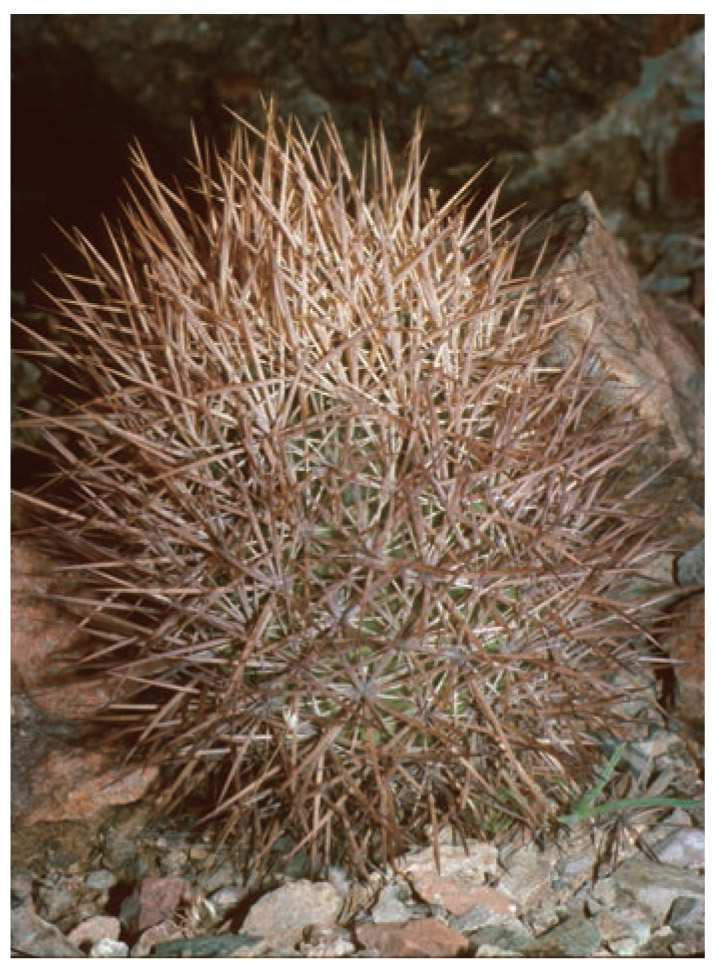
MANY-HEADED BARREL
Echinocactus polycephalus var. polycephalus
Cactus Family (Cactaceae)
Height: To 2’.
Flowers: Yellow tinged with pink; to 2” wide; followed by a fruit densely covered with white, woolly hairs to ¾” long; fruit to 1” long, ½” in diameter.
Stems: Roundish to cylindrical, hidden by spines; to 2’ long, 10” wide, with 13 to 21 ribs; numerous in dense clumps of up to 30 branches, to 4’ in diameter.
Spines: Central spines: reddish to pink with gray, felty, deciduous hair covering; rather flat; 4 per areole (3 near-straight, the fourth, lower spine curving downward); to 3” long. Radial spines: 6 to 8 per areole; to 1¾” long.
Blooms: February–March.
Elevation: 100 to 2,500’.
Habitat: Rocky or gravelly slopes.
Comments: A barrel cactus. Two species of Echinocactus in Arizona. Photograph taken in Kofa Mountains, February 21.

CLARET CUP CACTUS
Echinocereus coccineus (Echinocereus triglochidiatus var. melanacanthus)
Cactus Family (Cactaceae)
Height: To 6”.
Flowers: Scarlet, to scarlet-orange, with bright green stigma in center; to 1½” wide, 2¼” long; occurring at top of stem, followed by a 1”-long fruit with deciduous spines.
Stems: Green to bluish green, to 2½” in diameter; with 9 to 10 ribs forming a crowded clump.
Spines: Grayish, tan, or white; central spine to 2½” long.
Blooms: May–July.
Elevation: 4,000 to 9,000’.
Habitat: Open, rocky hillsides and ledges.
Comments: Two varieties of this cactus. Flowers remain open for several days. Fifteen species of Echinocereus in Arizona. Photograph taken near Greer, June 15.
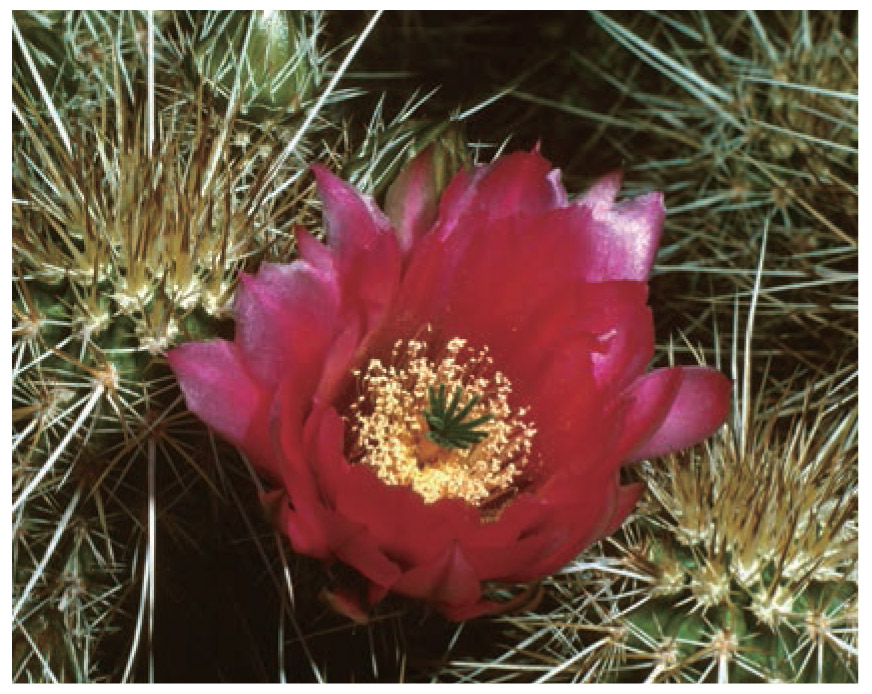
STRAWBERRY HEDGEHOG
Hedgehog Cactus
Echinocereus engelmannii
Cactus Family (Cactaceae)
Height: To 20”.
Flowers: Varying shades of magenta, with green stigma in center, cup-shaped; to 3” wide; bloom for several days, followed by green, spiny fruit (red when ripe), to 1¼” long, 1” in diameter.
Stems: Green and cylindrical, to 3” in diameter, with 10 to 13 ribs; forming loose or dense cluster to 3’ wide.
Spines: Color varies from whitish to golden yellow to pinkish to black; straight, central spines to 2” long; radial spines to 1” long.
Blooms: March–April.
Elevation: To 5,000’.
Habitat: Sandy and rocky flats and hillsides.
Comments: Fruits are edible; they produce a sugary juice and may be eaten like strawberries. Fifteen species of Echinocereus in Arizona. Photograph taken south of Phoenix, March 31.
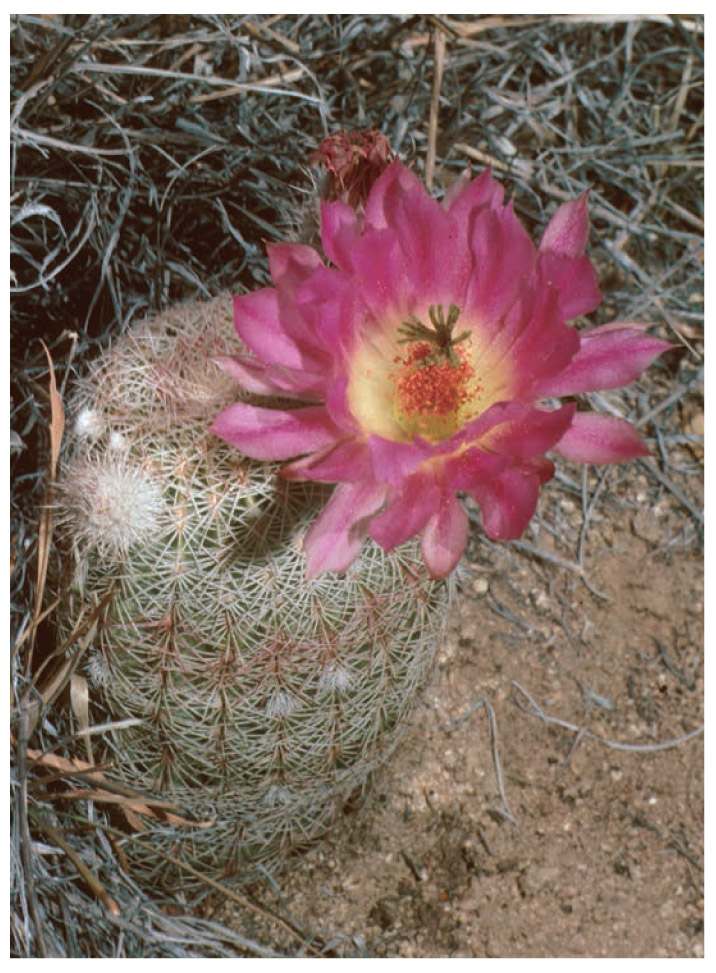
ARIZONA RAINBOW CACTUS
Echinocereus rigidissimus var. rigidissimus
Cactus Family (Cactaceae)
Height: To 1’.
Flowers: Magenta to lavender, funnel-shaped, to 5” wide; 1 to 4 flowers, followed by green to greenish purple, oval fruit to 2½” long.
Stems: Usually single, erect, and columnar, with some red to white spines forming alternating horizontal bands on stem; 15 to 22 ribs; to 4” in diameter.
Spines: Pink to gray to light brown; very dense, flat, comb-shaped, covering the entire stem.
Blooms: June–August.
Elevation: 4,000 to 6,000’.
Habitat: Grasslands, mountains, and limestone hills of southern Arizona.
Comments: Fifteen species of Echinocereus in Arizona. Photograph taken at Madera Canyon, June 10.
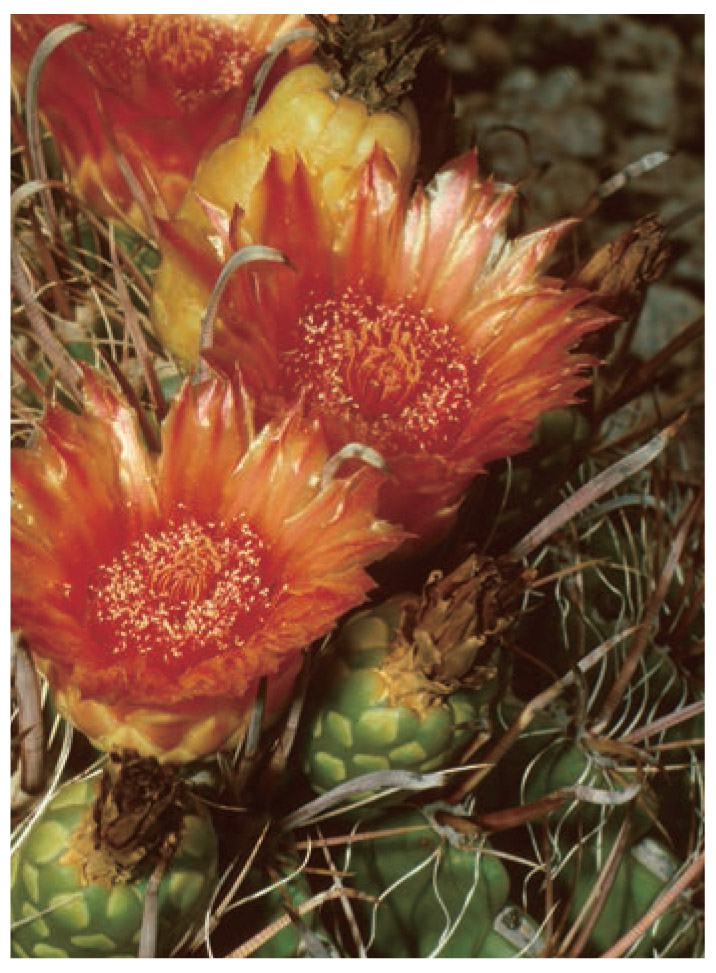
FISHHOOK BARREL CACTUS
Compass Barrel
Ferocactus wislizeni
Cactus Family (Cactaceae)
Height: To 11’ (usually much less), to 2’ in diameter.
Flowers: Shades of orange to yellow to reddish; cup-shaped; day-blooming; to 2½” wide; in crown at top of stem; followed by yellow, barrel-shaped, scaly fruit to 1¾” long, 1³⁄₈” in diameter.
Stems: Single, massive and cylindrical, with 20 to 28 ribs.
Spines: Grayish to reddish, in dense clusters along ribs; large, sharply hooked, flattened, central spine to 2” long, surrounded by slender, hairlike spines.
Blooms: July–September.
Elevation: 1,000 to 4,500’.
Habitat: Sandy desert and gravelly slopes in desert or grasslands.
Comments: Drawn toward direct sunlight; faster growth on the cactus’s shady side causes barrels to lean in a southerly direction, hence the name “compass” cactus. Instead of water, cactus is filled with a slimy alkaline juice. Yellow fruits persist all year. Three species of Ferocactus in Arizona. Photograph taken in vicinity of Mesa, July 13. The central spine on the similar Coville’s Barrel (Ferocactus emoryi) is normally not hooked, and is surrounded by stout, stiff spines.

DEVIL CHOLLA
Club Cholla
Grusonia emoryi (Opuntia stanlyi)
Cactus Family (Cactaceae)
Height: To 6”, rarely to 1’.
Flowers: Yellowish to greenish yellow; to 2” wide; followed by yellow, spiny fruit to 3” long, ¾” in diameter.
Joints: Cylindrical; to 6” long, 1½” in diameter.
Spines: Straw-colored to brownish, straight, 18 to 21 per areole; to 2” long.
Blooms: May–June.
Elevation: 2,500 to 4,000’.
Habitat: Plains and mesas in sandy soil.
Comments: Belongs to the club/mat-forming cholla group. Plants form mats several yards in diameter. There are several varieties of this species. Three species of Grusonia in Arizona. Photograph taken at Roper Lake, May 2.
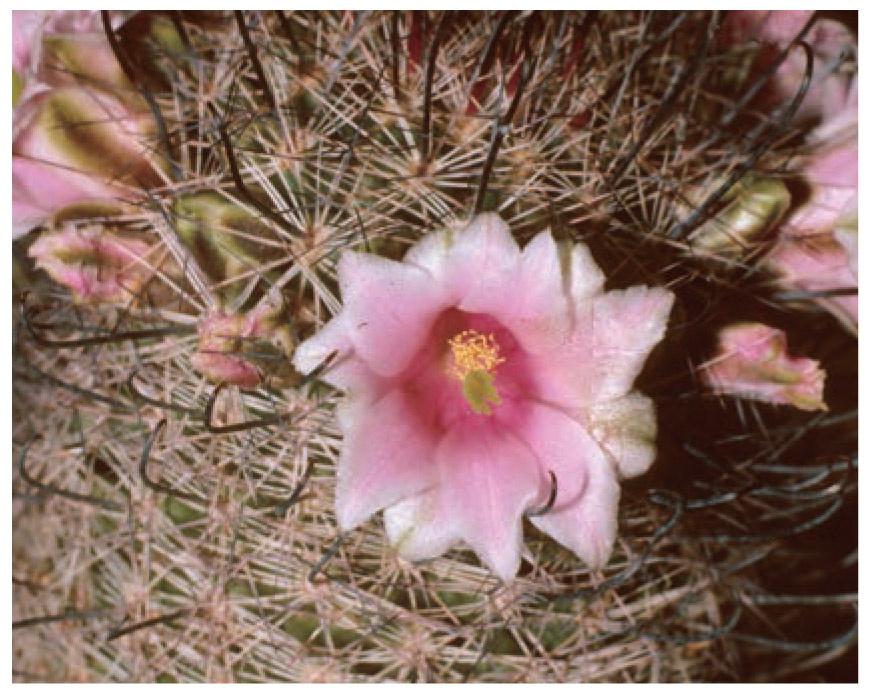
PINCUSHION CACTUS
Fishhook Cactus
Mammillaria grahamii var. grahamii (Mammillaria microcarpa)
Cactus Family (Cactaceae)
Height: To 6”.
Flowers: Pink to lavender; to 1” wide; forming crown at top of stem; lasting several days; followed by red, smooth, club-shaped fruit to 1” long.
Stems: Cylindrical, with close-set “nipples” obscured by spines; solitary at first, then branching, to 2” in diameter.
Spines: Grayish, dense, in clusters; central spine is dark reddish brown and hooked like an unbarbed fishhook.
Blooms: April–August.
Elevation: To 4,500’.
Habitat: Dry, gravelly areas in deserts; usually under bushes.
Comments: “Mammillaria” refers to nipplelike projections on stems. Pollinated by bees. Nine species of Mammillaria in Arizona. Photograph taken in Mesa area, July 21.

BEAVERTAIL CACTUS
Beavertail
Prickly Pear Opuntia basilaris
Cactus Family (Cactaceae)
Height: Grows in clumps 2’ high and up to 6’ in diameter.
Flowers: Pink to magenta; to 3” wide; at upper end of pad; followed by grayish, oval fruit to 1” long, sparsely covered with glochids.
Stems: Grayish green, with flat joint-pads; oval to spoon-shaped; spineless but with glochids; to 1’ long, 6” wide, ½” thick.
Spines: None; has clusters of very fine, brown to reddish brown glochids, to ¹⁄₈” long.
Blooms: March–May.
Elevation: 200 to 4,000’.
Habitat: Sandy or gravelly soils of canyons; washes or flats in desert.
Comments: Glochids detach easily upon contact and are difficult to remove. Joint or pad resembles a beaver’s tail. Pads root very easily. Native Americans used both fruits and pads for food. Pack rats feed on seeds. Twenty-four species of Opuntia in Arizona. Photograph taken at Cattail Cove State Park, March 18.
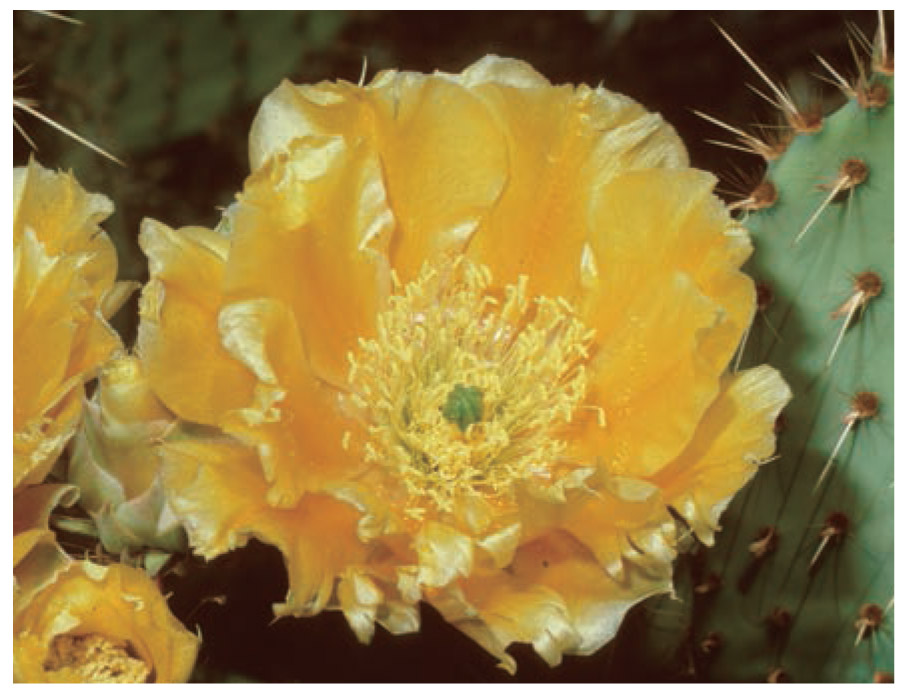
ENGELMANN’S PRICKLY PEAR
Nopal
Opuntia engelmannii (Opuntia phaeacantha var. discata)
Cactus Family (Cactaceae)
Height: To 5’.
Flowers: Yellow, orange, or reddish; to 3¼” wide; on edge of flat pad; followed by smooth, red to purplish, narrow-based, cylindrical fruit, to 3” long, 1½” in diameter.
Stems: Green to bluish green, with circular or oblong pad; to 16” long, to 9” wide; in upright or sprawling chains.
Spines: Ash gray to white, to 3” long, either flattened, curved, or straight. Areoles have brown or yellowish glochids.
Blooms: April–June.
Elevation: 1,500 to 7,500’.
Habitat: Sandy soils of flats, hills, and valleys in desert and grasslands.
Comments: Most common prickly pear in Arizona. A wide, spreading cactus to 15’ in diameter. Pollinated by bees. Fruits, called tunas, eaten by birds and rodents; also used for jelly and for making red dye. Javelinas eat pads. Stem pulp used to make face cream and water purifier. Glochids difficult to remove from skin. “Itching powder” was made from glochids. Twenty-four species of Opuntia in Arizona. Photograph taken at Usery Mountain Recreation Area, April 22.

MOHAVE PRICKLY PEAR
Grizzly Bear Prickly Pear
Opuntia polyacantha var. erinacea (Opuntia erinacea var. erinacea
and var. ursina)
Cactus Family (Cactaceae)
Height: To 1’.
Flowers: Reddish to pink to yellow; to 3½” wide, followed by brownish, elliptical fruit, to 1¼” long, ½” wide.
Stems: Bluish green, purplish on tips, elliptical to oblong; to 5” long, 2” wide.
Spines: White to pale gray, straight, long; longest at tip, reduced in size down joint; to 4” long.
Blooms: May–June.
Elevation: 3,000 to 7,000’.
Habitat: Sandy or gravelly soils or rocky hillsides in desert and woodlands.
Comments: In sprawling clumps. Twenty-four species of Opuntia in Arizona. Photograph taken near Sunset Crater National Monument, May 31.
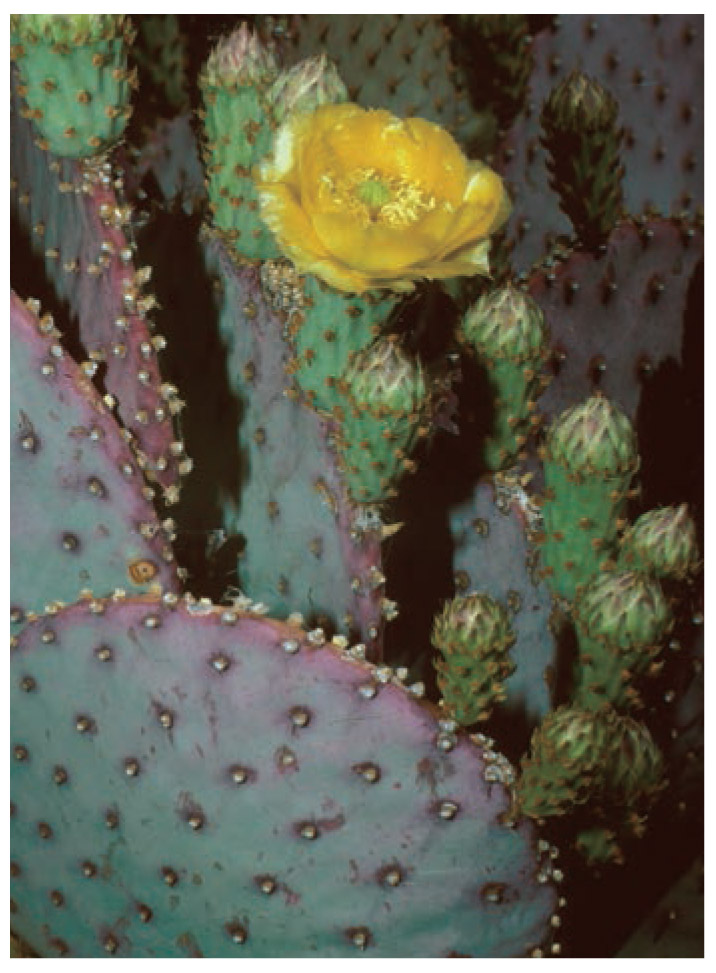
PURPLE PRICKLY PEAR
Santa Rita Prickly Pear
Opuntia santa-rita (Opuntia violacea var. santa-rita)
Cactus Family (Cactaceae)
Height: To 5’.
Flowers: Pale yellow; to 3½” wide; followed by red to purplish, smooth, slender fruit, to 1½” long, ¾” in diameter.
Stems: Greenish blue to pink to pale violet-purple; thin, flat, almost round; to 8” wide.
Spines: Few, if any. Reddish brown, to 3” long when present. Areoles, about 1” apart, have reddish brown glochids.
Blooms: Spring.
Elevation: Below 4,000’.
Habitat: Sandy or gravelly soils.
Comments: Color of pads varies with drought conditions or lower temperatures. Pads are eaten by rodents and cattle. This cactus is especially vulnerable to attack by tiny, cochineal scale insects, who reproduce and live under patches of sticky, white cottony fuzz, where they suck the juices from cactus pads. If fuzz is crushed a bright carmine-red dye is produced. Twenty-four species of Opuntia in Arizona. Photograph taken at Patagonia Lake State Park, May 10.

SENITA CACTUS
Old Man
Pachycereus schottii (Lophocereus schottii)
Cactus Family (Cactaceae)
Height: To 21’.
Flowers: Pale pink, nocturnal; to 1½” wide; often 2 or more at an areole, within hairlike area; followed by red, egg-shaped fruit to 1¼” long.
Stems: Green to gray-green, to 5” in diameter; with clumps to 15’ in diameter; 5 to 9 ribs.
Spines: Upper branches: gray, bristlelike, to 50 per areole, to 3” long. Lower branches: gray, 8 to 10 per areole, to ³⁄₈” long.
Blooms: April–August.
Elevation: 1,000 to 2,000’.
Habitat: Sandy soils of desert.
Comments: Concentration of these at Senita Basin at Organ Pipe Cactus National Monument in southwestern Arizona. Senita means “old one” in Spanish. When stems age, upper spines become gray and hairlike. One species of Pachycereus in Arizona. Photograph taken at Organ Pipe Cactus national Monument, October 23.
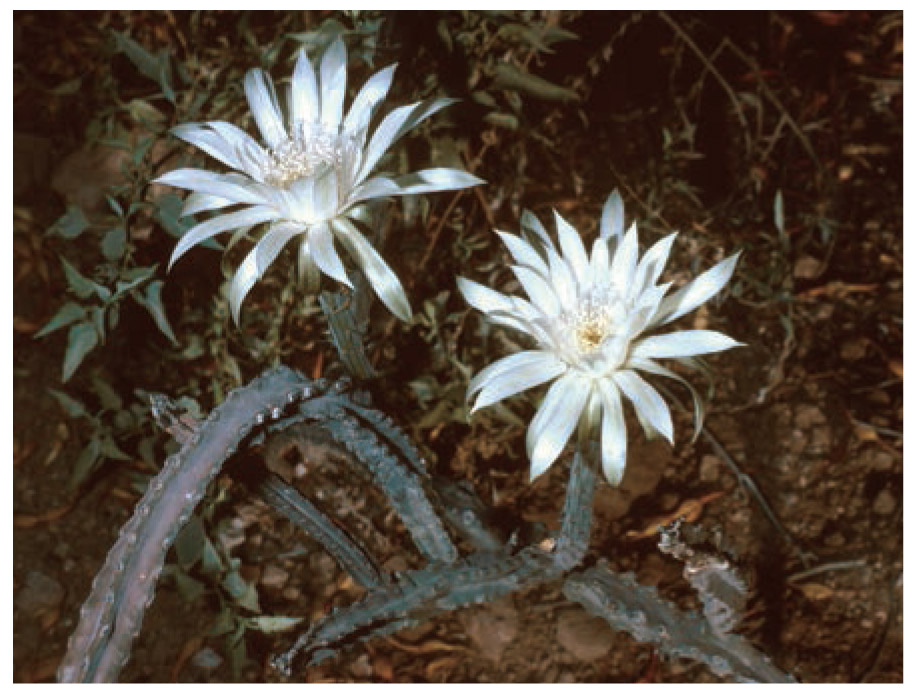
DESERT NIGHT-BLOOMING CEREUS
Arizona Queen-Of-The-Night
Peniocereus greggii
Cactus Family (Cactaceae)
Height: Erect or sprawling to 8’, but usually less.
Flowers: Waxy white, pointed, perianth segments; numerous white to yellow-tipped stamens; nocturnal, lasting only one night; very fragrant; to 4½” wide, 8½” long; followed by an orangish red, elliptical fruit with short spines, dulling with age, to 3” long, 1½” in diameter.
Stems: Lead-colored and slender, usually 4- to 5-ribbed; to ½” in diameter; unbranched or with up to 12 branches.
Spines: Dark-colored, about 11 to 13 per areole; upper spines to ¹⁄₃₂” long, lower ones to ¹⁄₈” long; with some whitish color.
Blooms: June–July.
Elevation: 1,000 to 3,500’.
Habitat: Desert flats and washes under trees or shrubs.
Comments: The inconspicuous, apparently dead stems are usually supported by branches of desert shrubs or trees. After dusk the flowers open in spasms, their aroma carrying as far as 100’ and attracting moths and other night-feeding insects. The blossoms wilt shortly after sunrise the following morning. The tuberous root is turniplike; 27 roots weighed at the University or Arizona ranged from 1½ to 43 pounds, but roots usually weigh 5 to 15 pounds. Two species of Peniocereus in Arizona. Photograph taken at Desert Botanical Garden, Phoenix, June 25.
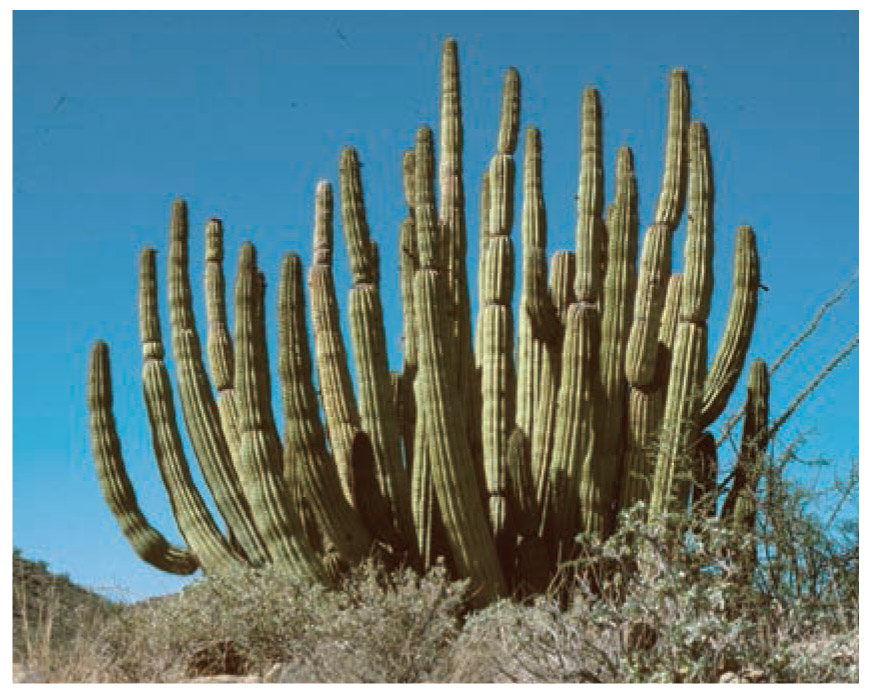
ORGAN PIPE CACTUS
Pitahaya Dulce
Stenocereus thurberi (Lemaireocereus thurberi)
Cactus Family (Cactaceae)
Height: To 20’.
Flowers: Pale lavender, nocturnal, funnel-shaped; to 3” wide; on sides or tips of stems; followed (in July) by a red, edible, nearly round, 3”-diameter spiny fruit.
Stems: Columnar cactus, free-branching, with stems arising from ground level; 12 to 20 ribs on stem; stems to 8” in diameter.
Spines: Brown to black, 11 to 19 per brownfelted areole; straight, to ½” long; spreading in all directions.
Blooms: May–June.
Elevation: 1000 to 3,500’.
Habitat: Stony desert and rocky hillsides of Organ Pipe Cactus National Monument.
Comments: Resembles pipes of an organ. Organ Pipe Cactus National Monument in southwestern Arizona was established to preserve this species. Tohono O’Odham Indians harvest fruits for syrup, using pulp and seeds for winter food. Sanborn’s long-nosed bats are the plant’s most important pollinators. One species of Stenocereus in Arizona. Photograph taken at Organ Pipe Cactus National Monument, March 30.